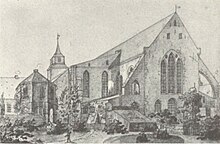The bell (Bremen)
The bell is a concert hall on Domsheide in downtown Bremen next to the cathedral . The building has been a listed building since 1973 .
history
In the 15th century, a tower-like building on the south side of the cathedral, which was connected to it by a corridor, was called the chapter house or, because of its shape, also called the “bell”. It belonged to the cathedral monastery , was used for deliberations by the cathedral chapter and, after 1648, also for court hearings . The octagonal building, an octagon with a conical roof and half-timbered walls on a round brick foundation , has been known through illustrations since the 18th century.
The new building, which was built in 1737 according to plans by the cathedral director and master builder (structural engineer) Caspar Friedrich Renner , was also octagonal and, when it became part of the Bremen cathedral in 1803, was used as a secondary school (at that time the school of scholars), for court and deputation meetings and for the safekeeping of Files used. In 1857 the building became the property of the artists' association , in which almost all personalities of artistic and scientific life were members. After a renovation by the architect Heinrich Müller , the building served as a club room. Celebrations and anniversaries, on whose design the painter and poet Arthur Fitger and the playwright Heinrich Bulthaupt had an influence, played a major role. After the halls were redesigned in 1869, the natural science collection was also housed here in 1877, which the Society Museum had given to the state until it went to the Northwest German Trade and Industry Exhibition in 1890 .
On January 26, 1915, the building was the victim of a major fire. In 1919 an architectural competition was organized for the new building, in which the Bremen architect Heinz Stoffregen won one of a total of six first prizes. His design included the preservation of the Gothic cloister , which was preserved during the fire, but was not implemented. The ruins were torn down in 1925, and the cloister was also destroyed.
Further name derivation
The tower of the Ostertor (East Gate) from the 13th / 14th centuries. Century, a passage through the city wall of the historic old town, over whose passage a bell hung, is mentioned as a further derivation of the name. It also served as a prison and was demolished in 1828. A bell that hung in this tower was placed in the Focke Museum and given to the Ansgariikirche around 1908.
The new bell
The new bell - built between 1926 and 1928 according to a design by Bremen architect Walter Görig with concert halls and a restaurant - took over the layout of the old cathedral monastery and was given a large stepped gable on the Domsheide . The building has been called The Bell since its inauguration .
Renovations
After repairing the damage from the Second World War , the bell was used by the occupying forces for club rooms until 1959 . A thorough renovation took place in 1995/1997, after which in 1999 busts of Ernst Wendel (1876–1938), Georg Kulenkampff (1898–1948), Hellmut Schnackenberg (1902–1974) and Ludwig Roselius (1902–1977) were placed in the foyer .
Acoustics
Because of its excellent acoustics, the bell has the reputation of a first-class concert hall. Herbert von Karajan counted the bell among the three best concert halls in Europe. And Margaret Price said: “ For singers, the bell is the best hall in the world! ".
operator
The operator, Glocke Veranstaltungs GmbH, is 100% owned by WFB Wirtschaftsförderung Bremen GmbH .
Halls and rooms
The halls and foyer are designed in the Art Deco style. The great hall with one tier has 1400 seats; the small hall has 391 seats. Differentiated foyer areas are available for this purpose. Halls and foyer are available for concerts, song evenings, readings, smaller congresses, lectures, banquets and other events.
Monument protection
The bell building and the chapter house of the cathedral parish adjoining it to the west are a joint listed building. The Jacobus figure in the Bible Garden is part of this object.
organ
The first organ in the concert hall was built in 1893/94 by the organ building company Eberhard Friedrich Walcker (Ludwigsburg). The instrument had 40 registers on three manuals and a pedal (mechanical cone chests). It was destroyed in a fire in 1915. Today's organ in the Bremen concert hall was built in 1928 by W. Sauer Orgelbau (Frankfurt / Oder). The instrument has 76 stops on four manuals and pedal (pneumatic pocket drawer). The actions are electro-pneumatic. In the years 2005–2008 the instrument was extensively restored by the organ builder Christian Scheffler (Sieversdorf).
|
|
|
|
|
|||||||||||||||||||||||||||||||||||||||||||||||||||||||||||||||||||||||||||||||||||||||||||||||||||||||||||||||||||||||||||||||||||||||||||||||||||||||||||||||||||||||||||||||||||||||||||||||||||||||||||||||||||||||||||||||||||||||||||||||||||||||||||||||||||||||||||||||||||||||||||||||||||||||||||||||||||
-
Pairing :
- Normal coupling: II / I, III / I, IV / I, III / II, IV / III, I / P, II / P, III / P, IV / P
- Sub-octave coupling: III / I, III / II, IV / IV
- Super octave coupling: III / I, III / II, IV / IV, P / P
- Playing aids : free combinations, hand registers, tutti, pedal switching, storage, crescendo roller
swell
- ^ Hermann Fitger in: Bremische Biographie 1912-1962 ; Verlag HM Hauschild, Bremen, 1969, page 480.
- ↑ Description on glocke.de. Retrieved December 26, 2012.
- ^ Monument database of the LfD .
literature
- Herbert Black Forest : The Great Bremen Lexicon . 2nd, updated, revised and expanded edition. Edition Temmen, Bremen 2003, ISBN 3-86108-693-X .
- Manianne Schwebel: "The bell" at the St. Petri Cathedral in Bremen. In: Bremisches Jahrbuch 77, 1998, pp. 266–276.
Web links
- Glocke.de - Homepage of the concert hall "Die Glocke"
Coordinates: 53 ° 4 ′ 30 " N , 8 ° 48 ′ 34" E



